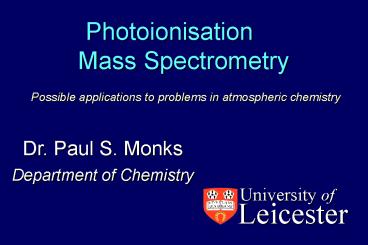Dr' Paul S' Monks PowerPoint PPT Presentation
1 / 46
Title: Dr' Paul S' Monks
1
Photoionisation Mass
Spectrometry Possible applications to problems
in atmospheric chemistry
Dr. Paul S. Monks Department of Chemistry
2
Photoionisation mass spectrometry
- A h? ? A e-
- Soft-ionisation
- Relatively low energy photons (3-30eV)
- Monochromatic
- Detect using mass spectrometry
- Specificity
- Sensitivity
3
- Photoionization Mass Spectrometry (PIMS)
- The Adiabatic ionization energy (IE) from the
photoionization threshold - The heat of formation of the ion from the IE
and the heat of formation of neutral - M ? M e
- ?fHo0(M) ?fHo0(M) IE
- Reaction pathways, branching fractions and
unambiguous product (isomer) identification - N C2H5 ? H2CN CH3 (0.4)
- ? NH C2H4 (0.6)
- The vibrational state and Rydberg state energy
levels
4
Experimental
5
Based on the discharge-flow technique
6
(No Transcript)
7
(No Transcript)
8
U11 (NSLS)
- Wide-angle acceptance wadsworth monochromator
- Iridium (water-cooled) mirror (gives 35eV
cut-off) - Grating 4m spherical concave
- 1mm spot
- 0.7-2x1013 photons s-1 (1000 mA, 100 mA)
9
The Nitrate Radical
10
Night-time tropospheric chemistry
NO3 NO2 O3 ? NO3 O2 k(T298K)
3.2x10-17 cm3 molecule-1 s-1 Daytime less
important as photolysed (t ? 5s)
11
Salisbury et al, JGR, 106, 12,669-12,688, 2001
12
- Ground state symmetry (D3h vs. C2v)
- Conflicting evidence both experimental and
theoretical as to ground electronic state and
geometry - D3h planar geometry (3-fold axis of symmetry)
- C2v one long and two short
- The PES of the two configurations are low lying
and separated by 0.1-0.33 eV dependent on the
level of electron correlation used in the
calculations - Electron configuration for a 2A2 ground state
- (s1s2s3)6(1a1')(1a2)(3e)4(4e4)(1e)4(1a2)1
13
Production of NO3
- Low Pressure (1-10 Torr)
- F2 ? F F (Microwave discharge)
- F HNO3 ? NO3 HF
- k(T298K) 3.0x10-11 cm3 molecule-1 s-1
14
Dissociative ionisation
- NO3 from HNO3
- Only ions m/z 63 (Parent) and m/z 46 (NO2)
- No NO or NO3 at ? ? 85 nm (?14.6 eV)
- HNO3 ? NO2 OH
- AE(NO2. HNO3) 12.125eV
15
Monks et al, JPC, 98, 10017, 1994.
16
? 98.675 ? 0.140 nm IE 12.565 ? 0.020
eV Sharp transition good FC overlap
17
NO3 larger IE than predicted by linear
progression Rationalisation delocalisation of
electron on O3 ring around N atom makes more
stable Supported by MP4 calculations
18
Cation symmetry D3h by 0.94eV over C2v
19
Ground state symmetry (D3h vs. C2v) ?
Conflicting evidence as to ground electronic
state and geometry From PIMS the experimental
photoionization threshold exhibits a large, steep
initial step with no evidence of significant
structure From Theory theoretical evidence is
unambiguous that the cation symmetry is D3h ?
Ionisation transition is NO3(1A1?) ?
NO3(2A2?) NO3 is most probably D3h
20
BrO
- Important in stratospheric chemistry
- Found in the troposphere from space
21
Polar Spring BrO Explosion
Courtesy of John Burrows Univ. Bremen
22
Generation of BrO (X2?)
- Br2 O(3P) ? BrO Br
- PES vs PIMS (Dunlavey et al., CPL, 53, 382, 1978)
- Interferences - Br2, O2, O Br and HBr
- Misassigned threshold and ?(0,1) as under Br2 ?
Br2 band
23
Select ion in complex mixtures (Br2O and OBrO)
24
Monks et al, CPL, 211, 416, 1993
25
IE 10.46 ? 0.02 eV (? 118.54 nm)
26
Why so much structure .
27
And then
- Dyke et al, (JCP, 112, 6262, 2000) re-measured
using PES and - IE(BrO) 10.46 ? 0.02 eV in agreement with PIMS
work
28
Halogen Oxides
29
FO from F NO3
Vibrational progression superimposed with
vibrational autoionization (high Rydberg states
that converge with an excited state of the cation)
30
I
Zhang et al, JPC, 100, 63, 1996
31
Br2O
Thorn et al, JPC, 100, 12199, 1996
OBrO
HOBr Monks et al, JCP, 1902, 1994
Thorn et al, JPC, 103, 8384, 1999
32
HOI
Monks et al, JPC, 99, 16566, 1995
IO
Zhang et al, JPC, 100, 63, 1996
33
(No Transcript)
34
Halogen Oxides
Ref 12 Thorn, R. P., Jr. Stief, L. J. Kuo,
S.C. Klemm, R.B., J. Phys. Chem., 1996, 100,
14178.
35
Planetary Atmospheres
Nitrile Compounds
Titan (Voyager Image)
Titans Haze
36
CH2CN Cyanomethyl radical
- Formed in
- C2H3 N(4S) ? Products
- Products and isomers of CH2CN and CH3CN
- Thermochemistry complicated
- C2H2N six (radical) isomers
- C2H3N five (molecule) isomers
- Thorn et al., JPCA, 1998, 102, 846
37
- Production of cyanomethyl
- F CH3CN ? CH2CN HF
- Production of vinyl
- F C2H4 ? HF C2H3
- ? H C2H3F
38
CH2CN IE 10.2810.012 eV
39
x 10
F CH3CN
C2H3 N(4S) ? C2H2N H
40
Obviously, not all linear ground-state but not
cyclic or NC equivocally - other isomers HCCNH
or H2CCN or HC-CHN unknown IEs
41
- For adduct
- C2H3 N(4S) ? C2H3N
- PIMS confirms product is acetonitrile
- Deuterated reaction another story
42
Measuring in the atmosphere
43
Radicals - day and night
44
PTR(CI) -TOF-MS
Developing HT-PTR-MS CI-TOF-MS for atmospheric
measurement applications
45
PIMS and the atmosphere
- PIMS is a tool for probing complex mechanisms,
identifying/ quantifying reaction products and
channels therefore ideal for atmospheric
oxidation mechanisms - NO3 DMS
- Organic complexity VOC/OVOC oxidation
- Understanding radical chemistry
- Specificity and sensitivity a power
46
Acknowledgements
- BNL Bruce Klemm, Steven Kuo, Zhengyu Zhang
- NASA (Goddard) Lou Stief, Peyton Thorn

